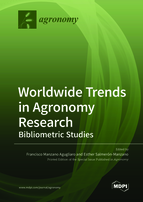Worldwide Trends in Agronomy Research: Bibliometric Studies
A special issue of Agronomy (ISSN 2073-4395).
Deadline for manuscript submissions: closed (30 June 2021) | Viewed by 56651
Special Issue Editors
Interests: remote sensing; UAV; land cover; land use; sustainability; agriculture; land change; energy; engineering; water
Special Issues, Collections and Topics in MDPI journals
Interests: sustainability; higher education; law; bibliometry; new technologies
Special Issues, Collections and Topics in MDPI journals
Special Issue Information
Dear Colleagues,
Agriculture has the large challenge of providing food for a continuously growing world population, while natural resources remain the same. This great challenge is certainly supported in the future by Agronomy, which brings together practical knowledge and scientifically based techniques and applies them to agricultural productivity. Research in agronomy at a global level must reflect global interests, while considering the particular conditions of each country or region. One of the main objectives of this Special Issue is to contribute studies that help to identify the global research trends in agronomy, especially if they have an approach related to sustainability. Therefore, articles reviewing this state of the art in any of these issues, bibliometric or scientometric studies, and research articles with a global perspective are welcome. These studies are recommended to identify the research trends in each scientific field related to agronomy and, if possible, identify the open challenges in that particular field of study.
Dr. Francisco Manzano Agugliaro
Dr. Esther Salmerón-Manzano
Guest Editors
Manuscript Submission Information
Manuscripts should be submitted online at www.mdpi.com by registering and logging in to this website. Once you are registered, click here to go to the submission form. Manuscripts can be submitted until the deadline. All submissions that pass pre-check are peer-reviewed. Accepted papers will be published continuously in the journal (as soon as accepted) and will be listed together on the special issue website. Research articles, review articles as well as short communications are invited. For planned papers, a title and short abstract (about 100 words) can be sent to the Editorial Office for announcement on this website.
Submitted manuscripts should not have been published previously, nor be under consideration for publication elsewhere (except conference proceedings papers). All manuscripts are thoroughly refereed through a single-blind peer-review process. A guide for authors and other relevant information for submission of manuscripts is available on the Instructions for Authors page. Agronomy is an international peer-reviewed open access monthly journal published by MDPI.
Please visit the Instructions for Authors page before submitting a manuscript. The Article Processing Charge (APC) for publication in this open access journal is 2600 CHF (Swiss Francs). Submitted papers should be well formatted and use good English. Authors may use MDPI's English editing service prior to publication or during author revisions.
Keywords
- agricultural engineering
- crop breeding and genetics
- farming sustainability
- horticultural and floricultural crops
- innovative cropping systems
- pest and disease
- soil and plant nutrition
- water use and irrigation
- weed science







